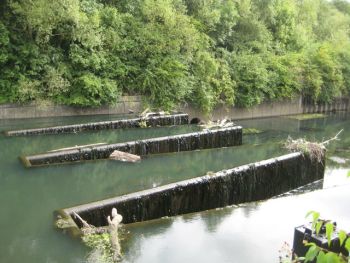Labyrinth Spillways

|
| Labyrinth Weir, London.
(Image Source: Wikimedia) |
“The flow capacity of a weir is largely governed by the weir length and crest shape. A labyrinth weir is a linear weir folded in plan-view; these structures offer several advantages when compared to linear weir structures. Labyrinth weirs provide an increase in crest length for a given channel width, thereby increasing flow capacity for a given upstream head. As a result of the increased flow capacity, these weirs require less free board in the upstream reservoir than linear weirs, which facilitates flood routing and increases reservoir storage capacity under base flow conditions (weir height may be increased). In addition to spillways, labyrinth weirs are also effective drop structures, energy dissipaters, and flow aeration control structures."[1]
The design of a labyrinth weir should include consideration of geometric configuration, hydraulic efficiency, and structural integrity. The dimensions and angles of a labyrinth weir's walls are essential in determining the flow capacity and head-discharge relationship. In general, as the head on a labyrinth weir increases, the overall efficiency of the weir decreases. This is due to localized submergence within the individual cycles of the weir. Comprehensive laboratory testingCite error: Closing </ref> missing for <ref> tag in the location of the in text mention. Citations will automatically populate below-->
Citations:
Revision ID: 7691
Revision Date: 09/28/2023
